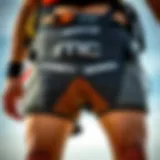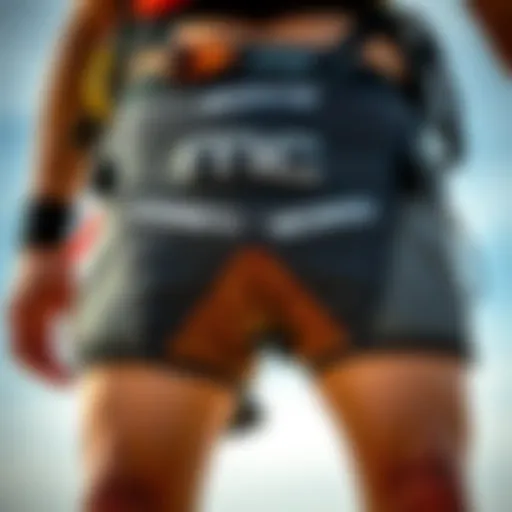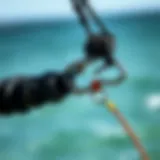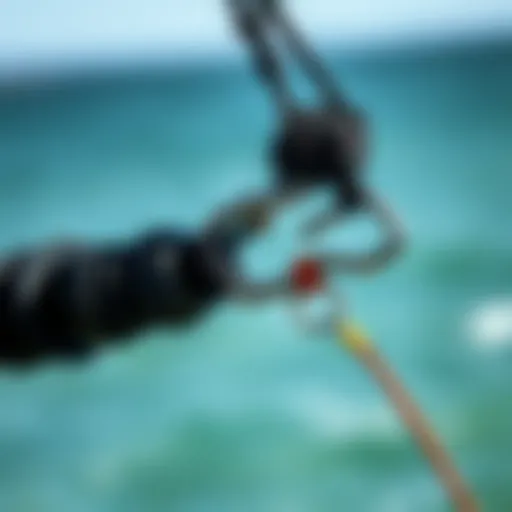Understanding Key Factors in Kite Sales
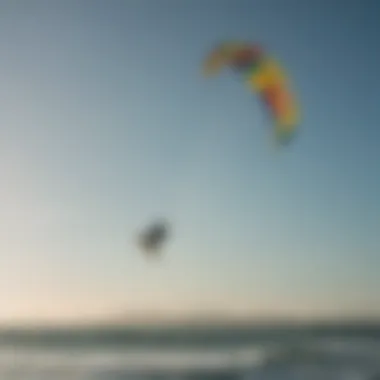

Intro
Kite sales have become a booming niche within the kiteboarding industry, a culture where enthusiasts and professionals alike search for the best gear that suits their needs. In a market teeming with options, understanding the facets of kite sales can significantly impact your experience on the water. This guide aims to shed light on factors that shape consumer choices, industry trends, and the importance of quality gear.
Purchasing a kite isn't just about aesthetics or brand reputation. It goes far deeper, touching on elements such as durability, technological advancements, and even community engagement. Moreover, being aware of seasonal influences on kite sales can help buyers pinpoint the right time for their purchases. This exploration of kite sales is essential for both newcomers and veterans, as they navigate through the intricate aspects shaping the kiteboarding experience.
Let's break down key insights into gear, delve into techniques, and explore various tips that will enrich one’s understanding of this exhilarating sport.
Gear Insights
When it comes to kiteboarding, the right equipment can make or break your experience. Understanding today’s gear landscape will guide you through the plethora of options available on the market.
Latest Gear Reviews
Regular reviews are indispensable for keeping up with the latest developments in kite gear. Here's a look into some standout products that have earned rave reviews:
- North Kiteboarding offers the DICE 2023, a versatile kite that thrives in various wind conditions, praised for its agility and responsiveness.
- Slingshot’s Ghost Whisper harness has been getting attention due to its comfort and lightweight design, making it an instant favorite among riders.
- Duotone’s latest Neo has emerged as a staple for wave riders, known for its stability and lift.
These reviews provide invaluable insights into performance metrics and user experiences, helping you make informed choices that align with your riding style.
Essential Gear for Beginners
If you’re just starting out, knowing what to look for can save you time and money. For novices, it’s crucial to invest in the basic, yet quality equipment. Here's a checklist:
- Kite: A beginner-friendly kite with good stability, such as the Cabrinha Switchblade, is ideal.
- Control Bar: A straightforward control system, preferably with safety features, like the Naish Control Bar, is essential for beginners.
- Harness: Comfort is key; consider choosing a harness with padding, like the Mystic Maaja, to avoid discomfort.
- Safety Gear: Never underestimate the importance of a reliable helmet and impact vest. Brands like Dakine provide excellent options tailored for safety without compromising performance.
Investing in the right kiteboarding gear as a beginner not only enhances safety but also boosts confidence, allowing you to enjoy the experience fully without the need to keep looking over your shoulder.
"Quality gear doesn’t just enhance your performance; it fosters a deeper connection to the sport, making every session memorable."
By staying informed about current gear trends and making selections based on individual needs and experiences, kite enthusiasts will find their journey far more rewarding. With the groundwork laid here, let's dive into advanced techniques to elevate your kiteboarding skills.
Understanding Kite Sales Dynamics
Understanding the dynamics of kite sales is pivotal in the kiteboarding industry. This knowledge sheds light on how consumer preferences evolve, what drives the market, and how various elements interplay to shape purchasing behavior. Being aware of these dynamics enables not only retailers but also consumers to make informed decisions. This section of the article will explore some critical aspects of kite sales that are vital for both newcomers and experienced kiteboarders.
One essential aspect is the influence of technology on gear development. Innovations in materials and design directly affect performance, durability, and user satisfaction. Consequently, understanding these advancements helps consumers find gear that suits their needs, boosting their overall experience.
Additionally, comprehending seasonal or geographical trends can provide insights into when and what types of kites are most likely to sell, assisting retailers in inventory management. This strategic foresight allows them to cater to customers more effectively, thus maximizing sales.
Furthermore, there’s the important factor of community engagement. How kiteboarding communities function, particularly through social media platforms like Facebook and Reddit, influences customer choices and brand loyalty. This engagement enhances the likelihood of repeat purchases as users share their experiences and recommendations.
In essence, delving into kite sales dynamics opens an array of opportunities to enhance both buyer and seller experiences in the market, paving the way for sustainable growth in the kiteboarding sector.
The Evolution of Kiteboarding Gear
Over the years, kiteboarding gear has undergone significant transformations. This evolution reflects advances in manufacturing technology and a deeper understanding of user requirements. Initially, kites were handcrafted from rudimentary materials, often resulting in inconsistent performance and durability. Today, many manufacturers use high-quality fabrics, advanced reinforcements, and aerodynamic designs that enhance speed and stability.
The integration of smart technology in kite roofs is an exciting development. Some kites now feature built-in sensors that communicate with smartphones, providing real-time data about wind conditions, kite tension, and even performance metrics. Such innovations aim to enhance the overall riding experience and offer personalized feedback to users.
Moreover, there has been a growing trend towards kite customization, where riders can choose colors, patterns, and performance characteristics that best suit their style and preferences.
Ultimately, understanding this evolution matters to anyone in the kiteboarding sphere. It highlights the importance of keeping up-to-date with the latest gear, which can directly influence performance, safety, and enjoyment on the water.
Consumer Behavior and Trends
Understanding consumer behavior in kite sales is crucial to grasp the underlying motivations that drive purchases. Demographics, such as age and skill level, play a substantial role. Beginners might lean towards more accessible, user-friendly options—kites that offer stability and ease of use—while experienced riders may prefer high-performance gear tailored for tricks and speed.
Another noticeable facet is the role of brand reputation. Brands that consistently deliver high-quality products are more likely to cultivate loyalty among their customers. Word-of-mouth and online reviews become essential influencers, as consumers tend to trust peers over traditional advertising.
Furthermore, the impact of environmental considerations cannot be overlooked. Today's customers are increasingly aware of sustainability and demand eco-friendly options. Brands that showcase their efforts to use sustainable materials and practices can gain a competitive edge, driving sales through ethical consumerism.
To summarize, understanding consumer behavior and trends provides valuable insight needed to cater effectively to a diverse audience. Juggling innovation, brand integrity, and environmental sensitivity is paramount for success in kite sales.
Market Analysis of Kites
Understanding the market dynamics of kites goes beyond just recognizing what is offered; it entails grasping the various elements that influence sales, consumer preferences, and brand reputation. The kiteboarding industry, while expertly vibrant and adventurous, experiences shifts that can change like the wind. This segment zeros in on the key components that forge the success of kite sales, making it essential for anyone climbing the ranks in this exhilarating sport.
Price Segmentation in Kite Sales
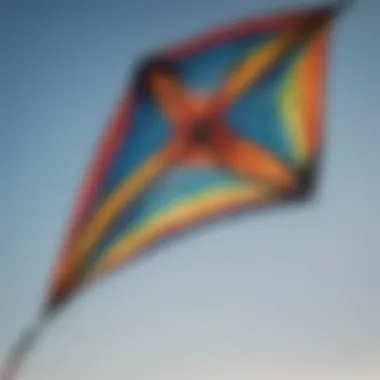

Price segmentation in kite sales plays a crucial role in determining not only the accessibility of the sport but also the diversity of gear available to different levels of enthusiasts. The kite market ranges from budget-friendly models, designed for newcomers trying their wings, to high-end kites that boast the latest technology and peak performance for seasoned riders.
When breaking down the pricing structure, distinct categories emerge:
- Entry-Level Kites: Generally priced between $200 to $500, these kites are tailored for beginners. They focus on durability and ease of control, helping novices build their skills without overwhelming pressure.
- Mid-Range Kites: With price tags ranging from $500 to $900, this segment attracts intermediate riders looking for better performance, responsive handling, and additional features like adjustable depower settings.
- High-End Kites: Here, prices typically soar past $900, featuring advanced materials, innovative designs, and unrivaled performance capabilities. They are targeted at pros who seek competitive edges and unique features like customizable wings.
In navigating this price landscape, potential buyers must weigh their own skill levels, budget constraints, and what kites serve their riding style best. Doing so ensures they don't just fly their kite but also embrace the kiteboarding lifestyle with confidence.
Popular Brands and Their Offerings
The realm of kiteboarding is populated with brands, each vying for attention through unique offerings and fierce marketing strategies. Recognizing the leading players can simplify the selection process for those engaged in the sport:
- North Kiteboarding: This brand is synonymous with quality and cutting-edge technology. Their kites are known for their wind range and versatility, suitable for both freeride and freestyle. Models like the North Neo and North Orbit have established a strong fanbase.
- Slingshot Sports: Once a small player, Slingshot has rocketed to prominence with products that intertwine innovative designs with performance. The Slingshot RPM and Slingshot Ghost cater to various riders, and their commitment to sustainability is a plus for the eco-conscious consumer.
- Ozone Kites: Renowned for their craftsmanship, Ozone kites appeal to adventure seekers. The Ozone Edge and Ozone Reo are widely respected for their performance and reliability in different wind conditions.
- F-One: This brand integrates style with functionality. Their kites, especially the F-One Bandit, have gained recognition for their excellent depower capabilities and responsiveness.
"Choosing the right kite can feel like picking the perfect companion for your adventure. Look for kites that resonate with your personal style and riding ambitions."
Thoroughly analyzing not just the kites but the brands behind them can boost confidence in your purchase decisions. Each brand brings something unique to the table, and getting a grip on their strengths can significantly drive happiness in the air.
Factors Influencing Kite Choice
Understanding the factors that influence kite choice is critical for anyone looking to purchase a kite for kiteboarding. The selection process can be overwhelming, given the plethora of options available. However, knowing what to prioritize can significantly improve the experience and overall satisfaction for beginners and experts alike.
Durability and Material Considerations
Durability is often top of mind for kiteboarders. Kites are exposed to harsh conditions, whether it's the relentless sun, strong winds, or even saltwater. The factors that determine a kite's durability include the materials used in its construction, such as ripstop nylon or polyester.
When evaluating a kite, look for reinforcement in areas prone to wear and tear such as the leading edge and the struts. A kite made with high-quality materials can withstand heavy use and unexpected accidents, prolonging its lifespan significantly. Consider the following:
- Fabric Quality: Opt for kites made from ripstop materials; they resist tearing and can endure significant stress.
- Seams and Stitching: Properly stitched seams prevent rips from spreading. Look for double stitching or tape reinforcement as a sign of durability.
- Bladders: Make sure the bladders are robust; punctured bladders can lead to a kite that deflates, ruining a session.
Investing in a durable kite may come with a higher upfront cost but could save money in the long run through reduced need for repairs or replacements.
Design and Performance Metrics
Performance metrics are another crucial element to consider when choosing a kite. These metrics can often be quantified to reflect how well a kite will perform in various conditions. The design of a kite directly influences its flying characteristics, responsiveness, and ability to handle challenging wind conditions.
A few key performance indicators to keep in mind include:
- Aspect Ratio: Generally, a higher aspect ratio means a faster, more efficient kite. It glides well but may be more challenging for beginners. A lower aspect ratio provides more stability and is easier to control.
- Shape and Size: Kites come in varying shapes and sizes, affecting their wind range and maneuverability. For instance, a delta-shaped kite is great for low wind conditions, while a bow kite offers better lift and is adaptable in varying winds.
- Bar Pressure: This determines how much force is required on the control bar to steer the kite. Adequate bar pressure contributes to an easy and enjoyable riding experience.
To get a practical feel for how a kite performs, it’s advisable to demo several types before making a purchase.
In summary, the factors influencing kite choice can be distilled into durability and performance metrics, both vital to enhancing not just the riding experience but also the longevity and value of your equipment. Paying close attention to these aspects will help you make a well-informed decision that meets your individual needs.
Seasonal Trends in Kite Sales
Understanding seasonal trends in kite sales is crucial for anyone involved in the kiteboarding industry, whether you are a retailer, a brand representative, or a dedicated enthusiast. The changes in seasons not only dictate wind patterns and water conditions but also play a significant role in consumer behavior and purchasing decisions. This section dives into the factors that drive kite sales through different times of the year, highlighting the importance of aligning business strategies with these trends.
Driving Factors in Seasonal Purchases
Several elements influence why kite sales fluctuate throughout the year. Here are some of the most significant factors:
- Seasonal Events and Competitions: Kiteboarding enthusiasts are often drawn to major events, exhibitions, or competitions scheduled during specific times of the year. This can create a surge in sales as attendees look to upgrade their gear beforehand. For instance, the annual Kite Surf World Cup often sees a spike in equipment purchases just before it kicks off, as athletes and thrill-seekers gear up to showcase their skills.
- Weather Patterns: The kitesurfing season can vary greatly by region. In some places, such as Hawaii or the Caribbean, the season might be year-round. However, in other locales, the summer months see the most action. Retailers must adjust their inventories accordingly, stocking up before the peak season to meet anticipated demands.
- Promotions and Discounts: Many retailers tend to offer sales during off-peak periods to clear out inventory. Understanding when these sales occur can be advantageous for both sellers and consumers seeking to snag a good deal. For example, post-summer clearance sales can attract both seasoned kiteboarders and newcomers looking to explore the sport without breaking the bank.
"Kiteboarding thrives in the summer sun, yet astute buyers know to watch for bargains in fall and winter, making the most of their budgets."
As seasons change, keeping an eye on these driving factors allows stakeholders to make informed choices, from stocking to purchasing, enhancing their overall kiteboarding experience.
Impact of Climate on Purchasing Patterns
Climate has more than a few tricks up its sleeve when it comes to influencing kite sales. Here are key aspects to consider:
- Temperature and Wind Conditions: Kiteboarding is, after all, about harnessing the wind. In regions where warmer temperatures bring consistent winds, there tends to be a corresponding increase in sales. Conversely, unexpected weather patterns or seasons of low wind can dampen enthusiasm, leading to a slowdown in purchases.
- Global Climate Trends: Over recent years, shifting climate patterns have also altered traditional kiteboarding calendars. For instance, places that once enjoyed predictable winds might find themselves dealing with increasing variability, thus affecting how retailers forecast their sales.
- Local Weather Events: Sudden weather events, like hurricanes or storms, can profoundly impact local markets. Post-event recovery periods might prompt a surge in replacements, as gear damaged in storms needs to be replaced. Retailers must remain agile, ready to adjust product lines based on climatic conditions.
Understanding the climate's role as a double-edged sword is essential for kite retailers and buyers alike, harnessing its whims to make better purchasing decisions.
Seasonality is not just about the calendar; it's about reading the winds of change in consumer behavior and market dynamics.
Through keeping tabs on these trends and adjusting accordingly, anyone in the kite sales business can find their footing amidst the waves.
Kiteboarding Communities and Their Influence


Kiteboarding is more than just a sport; it’s a lifestyle that thrives on community connections. These communities play a pivotal role in the kite sales ecosystem, guiding enthusiasts and newcomers alike through their purchasing journey. The buzz among enthusiasts is often where the value of kites and gear is truly recognized, aiding consumers in separating the wheat from the chaff. From beaches to online forums, the influence of kiteboarding communities can be felt everywhere, serving not only as a nexus for connection but also as a powerful driver of sales.
Role of Social Media in Kite Sales
Social media has transformed the landscape of kite sales significantly. Platforms such as Facebook and Instagram are alive with vibrant kiteboarding activities, showcasing thrilling stunts and scenic locales. These platforms allow users to share their experiences in real time, essentially creating a word-of-mouth akin to yesteryears but amplified on a global scale.
- Instant Reach: Information spreads like wildfire. A glowing review from a local influencer can lead to spikes in interest for specific kite brands. This essentially turns enthusiasts into brand ambassadors, helping to validate products for potential buyers.
- Visual Storytelling: Pictures speak louder than words. When someone shares a photo of themselves riding the waves with a new kite, it’s more appealing than any advertisement. Users often find themselves captivated, keen to emulate what they see.
- Affinity Groups: Groups on social media are a breeding ground for discussions about gear. Members share tips about kite characteristics, model comparisons, and even recommendations based on climate and skill level. The effect of this communal learning can seriously sway a consumer's decision.
Ultimately, social media enhances transparency in kite sales, allowing buyers to explore a wealth of opinions before making financial commitments.
User Reviews and Recommendations
User reviews serve as the modern-day north star for many kiteboarders navigating the purchasing landscape. With the advancement of e-commerce, the power of honest feedback from real users cannot be overstated.
- Trustworthiness: Today’s consumers are savvy. They often turn to platforms like Reddit or specialized forums before they click 'buy.' Positive reviews and high ratings can elevate a brand’s reputation, while negative experiences communicated by users can quickly tarnish it.
- In-Depth Insights: Users often document their experiences, detailing everything from performance in varied wind conditions to durability aspects. Such knowledge helps prospective buyers make informed purchases rather than relying solely on advertisements or brand claims.
- Community Validation: A recommendation from a fellow kiteboarding enthusiast can outweigh branded marketing efforts. When users mention which kites they personally love or how certain gear helped them level up their skills, potential customers feel more confident in their choices.
"Kiteboarding communities play a crucial role in informing and guiding novice and expert riders alike. The shared experiences help potential buyers navigate the stormy seas of options available."
In summary, kiteboarding communities, bolstered by social media and authentic user reviews, not only cultivate a sense of belonging among enthusiasts but also significantly influence kite sales. In a world where informed choices are paramount, the voices from the community have become indispensable in steering potential customers toward the right gear.
Sustainability in Kite Manufacturing
In today's world, where environmental concerns loom larger than ever, sustainability in kite manufacturing emerges as a paramount topic for both consumers and manufacturers alike. The kiteboarding community is becoming increasingly aware of the ecological impact of the products they use, pushing for practices that not only enhance their experiences on the water but also protect it for future generations. This section delves into the significance of sustainability in kite manufacturing, highlighting how innovative practices and materials contribute to an eco-friendly kiteboarding industry.
Eco-Friendly Materials and Practices
The journey towards sustainability in kite manufacturing begins with material selection. Traditionally, kites have been made with nylon and polyester, but innovative manufacturers are now focusing on sourcing materials that are less harmful to the environment. For instance, companies are exploring biodegradable materials and recycled fabrics, which can significantly reduce the carbon footprint of kite production.
Some brands have taken bold steps by incorporating natural fibers, such as hemp or organic cotton, into their designs. These materials not only offer durability and performance but also break down more easily in nature, minimizing the end-of-life impact of kites. Furthermore, embracing manufacturing practices that reduce waste is crucial.
For example, by using precision cutting techniques to minimize offcuts and implementing water-based adhesives instead of harsh chemicals, manufacturers can create kites that are gentler on the planet.
Incorporating renewable energy sources in production facilities also aligns well with sustainability goals. Many leading brands are making the switch to solar or wind energy to power their operations, proving that cutting-edge performance and environmental responsibility can go hand in hand.
Consumer Expectations Regarding Sustainability
As kites and kiteboarding gear evolve, so do consumer expectations. Today's kiteboarders, whether they are seasoned pros or weekend warriors, are increasingly looking for products that reflect their values. An ALMOST universal desire for eco-conscious products is shaping purchasing decisions.
Surveys conducted within the kiteboarding community show that a significant percentage of buyers are willing to pay more for kites that use sustainable practices or materials. It's no longer simply about performance on the water; the environmental impact has become a critical criterion in the decision-making process.
Communities that advocate for sustainability are also creating a ripple effect in the market. Many kiteboarders actively engage in discussions on platforms like Reddit and Facebook, exchanging insights about environmentally friendly brands. This peer influence can drive other consumers towards brands that are genuinely committed to sustainability. Moreover, word-of-mouth recommendations can swiftly amplify a brand's commitment to eco-friendly practices.
"In today's world, being green is not just nice; it's a necessity. Shoppers are paying attention, and companies that ignore this shift may find themselves left in the dust."
Ultimately, as kiteboarders look forward to the next wave, they must consider the impact of their choices. The synergy between sustainability, consumer values, and innovative practices can pave the way for a more environmentally responsible kiteboarding industry.
Local Markets and Kite Sales
Local markets play a significant role in the kite sales industry. Understanding the dynamics of these markets not only helps businesses cater to the specific needs of kiteboarding enthusiasts but also allows consumers to make informed choices tailored to their preferences. Each region brings its unique culture, weather patterns, and consumer behavior, influencing both the types of kites sold and the frequency of purchases.
One of the advantages of local markets is the ability to connect with customers on a personal level. Vendors who operate in these areas often know their clientele well, which enables them to recommend products that align with local trends. For instance, in coastal regions with consistent winds, you might find more demand for specific kite types—like delta kites—easier to maneuver in such conditions.
For businesses, effective marketing strategies in local contexts can lead to increased brand loyalty, as customers often prefer to support local enterprises over larger, impersonal companies. This connection can foster a sense of community, where word-of-mouth recommendations become a powerful tool in driving sales.
Regional Preferences and Trends
Diving deeper into regional preferences reveals how local kiteboarding communities have distinct tastes and demands. For instance, in the Pacific Northwest of the United States, you'll find many kiteboarders favoring durable, heavy-duty kites that can withstand the area's unpredictable weather. Conversely, in locations like Florida, lighter kites are preferred due to the consistent warm weather and lighter winds.
This disparity means that manufacturers and retailers should consider local environmental conditions and user skill levels when planning their product lines. Kite shops in these regions often balance their offerings between beginner-friendly models and high-performance gear for more experienced riders, adapting inventory based on regional trends and preferences. Understanding these nuances aids in effective inventory management, ensuring shops cater to every customer’s needs.
Index of Popular Kiteboarding Destinations
Having a grasp on the most favorable kiteboarding destinations is also pivotal for local sales. Locations such as:
- Cabarete, Dominican Republic
- Maui, Hawaii
- Tarifa, Spain
These destinations often become hotspot for kiteboard enthusiasts. Local shops thrive by tailoring their stock to meet the needs of travelers arriving in droves, eager to purchase equipment suitable for these iconic spots.
Local markets also benefit from attracting tourists. Kite shops situated near popular beaches not only capitalize on regional demand but also on traveling kiteboarders looking for top-quality gear. As these shops adapt their inventories according to the seasonal influx of visitors, they also create marketing strategies that highlight local events or competitions. This type of engagement amplifies their visibility and connects them with the kiteboarding community at large.
"Local insights are the compass that guides kite sales, steering businesses toward consumer preferences that vary across regions."


By considering these factors, the kiteboarding industry can build a comprehensive strategy that not only focuses on product diversity but also on understanding the local market's cultural nuances. Adapting inventory and marketing efforts to resonate with the audience can lead to heightened consumer satisfaction and loyalty.
Technological Innovation in Kites
In the kiteboarding trade, technological innovation stands as a cornerstone that shapes all aspects of the sport. As kite aficionados hunt for the ultimate ride, manufacturers are stretched to their limits to innovate and keep their gear not just relevant, but state-of-the-art. Enhanced design features and functionalities represent significant shifts that cater to every kiteboarder’s needs. The impact of technological advancements cannot be overstated—it really can make or break the experience on the water.
Advancements in Kite Design and Functionality
The last few years have seen considerable transformations in how kites are designed. It’s as if aerodynamics got a complete makeover. The introduction of materials like ripstop nylon and advanced layouts has led to kites that are lighter yet more durable. These innovations not only enhance performance but also increase the lifespan of the gear.
A key feature of modern kites is the incorporation of adjustable settings that allow riders to customize the experience according to wind conditions. With features such as bridles and trim systems, users can modify how the kite behaves simply by adjusting a couple of lines. This is a game-changer, especially for those kiteboarders who often find themselves transitioning between different environments and conditions.
Some of the notable trends include:
- Increased Use of New Materials: Today's kites utilize advanced constructions that can withstand harsh conditions while reducing weight.
- Improved Shape Dynamics: With the change in shape and aspect ratios, kites have become more efficient.
- User-Centric Design: Manufacturers are now involving riders from the initial design processes, leading to products that genuinely address user preferences.
Adaptive Kites for Different Skill Levels
What truly sets the kiteboarding market apart is the availability of adaptive kites designed specifically to cater to diverse skill levels. Whether you’re just dipping your toes or you’re a seasoned pro hitting those high jumps, there’s a kite tailored for you. This diversification ensures that everyone finds kites that match their skill set.
Beginners often feel overwhelmed by the myriad of choices available. To address this, brands have cut back on technical complexity, producing kites that are stable and easy to control. These user-friendly kites typically have a larger surface area which captures more wind, making it easier for newcomers to get off the ground without too much fuss.
On the flip side, experienced riders can choose kites featuring advanced technology like responsive bridle systems and unique wing designs that manipulate lift and drag. Notably:
- Beginner Kites: User-friendly, focusing on stability and ease of use.
- Intermediate Kites: Balancing performance and manageability, encouraging skill growth without overwhelming the rider.
- Advanced Kites: Emphasizing performance and agility, these kites are often tuned for ambitious maneuvers.
Ultimately, the innovative designs and adaptability of kites ensure that whether one is a novice taking those humble first flights or an expert mastering aerial tricks, there’s something within reach.
"The right equipment can lift your experience beyond the mundane, making each ride a thrilling adventure."
In summary, the path towards superior kite designs and functionality, as well as the adaptability to various skill levels, not only enhances individual experiences but also injects vitality into the kiteboarding market. As technology continues to evolve, so will the options available, truly democratizing access to an exhilarating sport.
Kite Storage and Maintenance
Kite storage and maintenance play a crucial role in extending the lifespan of your gear. By taking proper care of your kites, not only can you ensure their performance, but you can also save yourself a pretty penny in replacement costs. Regular maintenance practices may feel like an inconvenience at times, but they are foundational for enjoying your kiteboarding adventures to the fullest. With the right tips and routines in place, you can turn the tedious task of storage into a well-established habit that benefits your kiteboarding experience.
Proper Care Techniques for Longevity
To kick things off, let’s talk about proper care techniques that can help you get the most out of your kites. First and foremost, a clean kite is a happy kite. After each session, it's best to rinse your kite with fresh water to remove sand, salt, and other debris that might cling to it. These elements can cause wear and tear, affecting its aerodynamics and longevity.
- Dry it out: Once rinsed, ensure your kite is thoroughly dried before folding it up. Storing a damp kite can lead to mildew and even material degradation. If you’re pressed for time, a dry towel can speed up this process.
- Inspect regularly: Check for any visible damage like tears or frays. Addressing minor issues right away can prevent more significant problems down the line. Remember, a stitch in time saves nine.
- Use proper storage bags: Store your kite in a protective bag to keep it safe from UV rays and other environmental factors. A well-ventilated area is ideal, free from extreme temperatures and humidity, as these conditions can deteriorate both the material and the shape of the kite.
The aforementioned techniques sound basic, but they work wonders. They ensure that your kite not only operates effectively but also retains its aesthetic appeal.
Seasonal Maintenance Routines
As seasons change, so too should your approach to kite maintenance. Each season presents unique challenges, and by adapting your routines accordingly, you’ll ensure that your gear remains in peak condition.
- Spring Check: Before heading out for the first session after winter, conduct a comprehensive inspection. Check for wear and tear, and replace any components that may have deteriorated during storage.
- Summer Touch-ups: In the heat of summer, UV rays can wreak havoc on your kite. Apply a UV protectant spray before your sessions. It’s like sunscreen for your gear!
- Autumn Prep: As the leaves start to fall, take the time to give your kite a thorough clean before winter storage. This is also a good opportunity to patch up any damage.
- Winter Care: Even if you are not kiting during the colder months, avoid leaving your equipment in extreme temperatures. Store it indoors to prevent materials from becoming brittle.
"The life of a kite is not just in flying but in the love and care it receives off the water."
Ending and Future Trends
As we reach the tail end of this exploration into kite sales, it's crucial to highlight how understanding the intricacies of the kiteboarding market equips enthusiasts with the right tools to navigate their purchases. The importance of this section lies in stitching together various threads discussed throughout the article, painting a comprehensive picture of where the market currently stands and where it’s heading.
The kiteboarding sphere is not static; it’s a dynamic blend of innovation, market forces, and environmental considerations. As kiteboarders—be they weekend warriors or seasoned pros—stay informed about the fluctuating trends and consumer behaviors, they position themselves favorably to make choices that enhance their overall experience.
Predictions for the Kite Market
Looking ahead, the kite market shows signs of promising growth, influenced heavily by technological innovations and a rising awareness about eco-friendly practices.
- Emerging Technologies: Expect to see kites that adapt to various skill levels but also come equipped with tech features, like sensors that gauge wind conditions or connectivity options to track performance metrics.
- Sustainable Practices: As consumer preferences shift towards sustainability, companies are likely to innovate further in using recycled materials and reducing waste, creating kites that are not only high-performing but also environmentally friendly.
- Diversification of Offerings: Brands will likely expand their product lines to cater to niche markets within kiteboarding, such as kites designed specifically for light wind, large riders, or more challenging wave conditions. This could bring about specialized kites tailored to what different regions or demographics need.
- Global Reach: With the sport growing in popularity across the globe, especially in countries previously considered off the radar, kite brands are bound to amplify their marketing efforts in these new markets.
These predictions make it clear that both manufacturers and consumers must remain adaptable, embracing changes while also demanding products that align with their values and needs.
Final Thoughts on Kite Sales and Sustainability
The conversation about kite sales cannot escape the urgent topic of sustainability. Shoppers are exploring choices that not only satisfy their thirst for thrill but also act as stewards of the environment. This booming demand for responsible manufacturing shapes the future landscape of kite sales.
It's beneficial for consumers to consider:
- Prioritizing brands that align with eco-friendly practices, such as Ozone Kites or Naish, which have been pioneers in sustainable kite design.
- Understanding that their purchasing decisions can either contribute to or combat ecological degradation. This awareness leads to more informed choices, encouraging companies to adopt green practices to keep step with consumer expectations.
"To ensure a better future for kiteboarding, we need to make conscientious choices today. Every kite sold with sustainability in mind pushes the industry to reevaluate what it means to be eco-friendly."
Thus, sustainability goes beyond just a trend; it’s a pivotal element in kite sales that holds substantial weight in shaping the direction of the industry. While riding the waves, kiteboarders can take pride in knowing that they are part of a movement that respects our planet while indulging in their passion for the sport.








